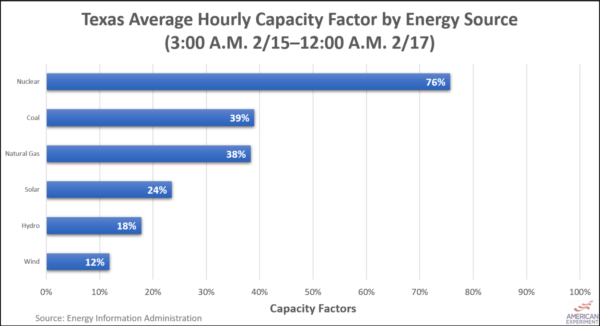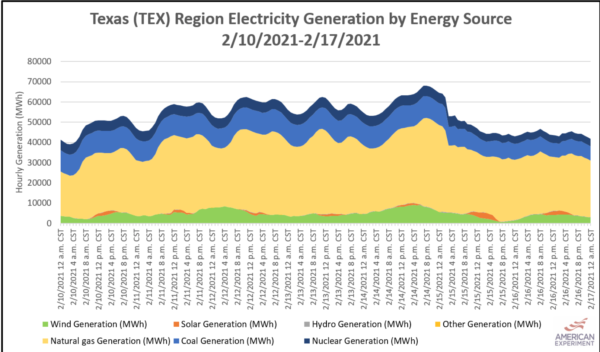The best explanation of Texas’s prolonged blackout was published by Mitch Rolling yesterday at AmericanExperiment.org. Texas gets electricity from six sources: coal, nuclear, natural gas, solar, hydro and wind. How did those sources perform, and what contributed to the blackout?
[W]e created a reliability grading scale designed to judge which energy sources came to the rescue, and which ones were largely no-shows, during the statewide power outages that rocked Texas.
***
For our grades, we used average capacity factors over the course of the Texas power outages to showcase which energy sources were performing the best, and which ones were non-factors. The graph below displays these capacity factors.

As everyone knows, some natural gas pipelines froze, contributing to the blackout. However:
Remarkably, natural gas still generated electricity at 38 percent of its total capacity throughout the energy emergency – providing on average over 65 percent of all electricity generation through Monday and Tuesday – despite roughly 30 GW being inoperable due to frozen pipelines holding up fuel.
It was the “green” energy sources that failed to show up for work:
The three worst-performing generating assets, on the other hand, belonged exclusively to renewable energy sources: solar, hydro, and wind. Had Texas been even more reliant on these energy sources, as renewable energy advocates around the country desire, the energy crisis in Texas would have been even worse.
This chart shows the contribution to total electricity production made by each energy source over the course of the blackout. Solar was irrelevant, and wind virtually irrelevant as well:

The fatal flaw of wind energy is that it only works, at best, 40% of the time. When the wind doesn’t blow–as it tends not to during times of bitter cold–wind turbines are useless. The fact that some wind turbines froze up is interesting, but far from the main point.
In case you missed it, wind energy scored an F in all three categories – the only energy source to perform so poorly during the power outages in Texas.
As such, you can rightfully label wind energy as the most unreliable energy source during the Texas energy crisis. While it may not have been the primary cause of the power outages, it certainly wouldn’t have done Texas any good to have more wind capacity on the system. In fact, more wind capacity would have only made things worse.
***
If this grading scale tells us anything, it’s that relying on intermittent renewable energy during extreme weather events is not the answer to maintain reliability, and fuel-based energy sources are required in order to keep the lights on.
Much more at the link. One other comment: when it gets really cold–Minnesota cold, not Texas cold–all wind turbines are shut off, and they draw power off the grid to heat their motors. So when it is really cold, wind turbines are consumers of electricity, not producers.
Notice: All comments are subject to moderation. Our comments are intended to be a forum for civil discourse bearing on the subject under discussion. Commenters who stray beyond the bounds of civility or employ what we deem gratuitous vulgarity in a comment — including, but not limited to, “s***,” “f***,” “a*******,” or one of their many variants — will be banned without further notice in the sole discretion of the site moderator.